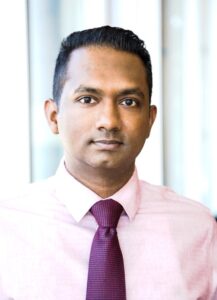VINSE Colloquium Joint Seminar with Data Science Institute “Nanophotonics: The Role of Ultrafast Spectroscopy in Shrinking Light-Based Technologies” Krishen Appavoo 2/9/22
Dr. Kannatasssen (Krishen) Appavoo
Assistant Professor
Department of Physics
University of Alabama, Birmingham
“Nanophotonics: The Role of Ultrafast Spectroscopy in Shrinking Light-Based Technologies”
4:10 PM, 134 Featheringill Hall
Abstract. Our ability to develop disruptive technologies is intimately tied with our ability to mold the flow of light at length scales below the optical diffraction limit. Equally important is our ability to collect information on the dynamics of these systems in order to understand novel and unexpected fundamental nanoscale physical and chemical processes. In some cases, understanding the first few picoseconds after light absorption can be critical to tailoring the overall performance of nanoscale devices. In this talk, I describe our nanophotonics research program at UAB that develops novel building blocks for next-generation technologies in the energy conversion, communications and quantum sectors. Specifically, I discuss how our group employs advanced laser spectroscopy, electron microscopy and machine-learning techniques to interrogate nanophotonic materials—testing how key parameters such as size, geometry, dielectric function and carrier density modify light-matter interaction at nanometer length and femtosecond time scales. These studies, sometimes performed while the device is under operation, include (i) fabricating and testing state-of-the-art photovoltaic thin-film materials such as hybrid organic-inorganic perovskites; (ii) designing and fabricating metasurfaces capable of squeezing light to nanoscale dimensions to enable novel collective optical and electronic phenomena that cannot be obtained with natural materials; (iii) using subwavelength, highly crystalline nanospheres to fabricate a solution-processed thin-film laser with thickness and energy-input threshold at least an order of magnitude lower than previously demonstrated. Overall, these experimental studies coupled with machine-learning techniques provide physical insights on how to couple elementary excitations in materials with nanoscale light fields to mitigate losses, thus providing a means to develop robust nanoscale architectures for integration in energy and quantum systems.
Bio. Prof. Appavoo is originally from Mauritius, an island nation in the Indian Ocean. In 2004, he moved to the United States to pursue his undergraduate studies at Berea College, graduating with bachelor’s degrees in physics and mathematics. After a research internship at IBM Almaden Center, he became interested in optics, and the physics of phase-change materials for its applications in modulators and memory devices. He joined Vanderbilt University in 2008 to conduct his doctoral work under the supervision of Professor Richard Haglund. His work focused on the designing, 3D-simulation, nanofabrication, and ultrafast optical characterization of hybrid nanosystems that combined metamaterial elements with vanadium dioxide — a phase-change material that can undergo an insulator-to-metal transition in less than one millionth of one millionth of a second (a picosecond).
After earning his PhD in 2012, he joined Brookhaven National Laboratory as a Goldhaber Fellow, working with Dr. Matthew Sfeir at the Center for Functional Nanomaterials. His research aimed at understanding microscopic processes that are critical to determining the overall efficiency of energy-to-fuel conversion and which typically occur on ultrafast timescales. Building advanced time-resolved optical experiments that probed the microscopic interactions of these nanostructures during device operation, i.e., in situ spectroscopy, was a major focus of his research.
In 2016, Prof. Appavoo joined the Physics faculty of UAB. He currently manages the Laboratory for Nanoscale and Quantum Photonics group. His research group focuses on ultrafast spectroscopy of nanostructured systems for energy, optoelectronics and quantum applications. Using machine learning techniques to efficiently design and inspect nanophotonics elements has quickly become an integral part of his group.

